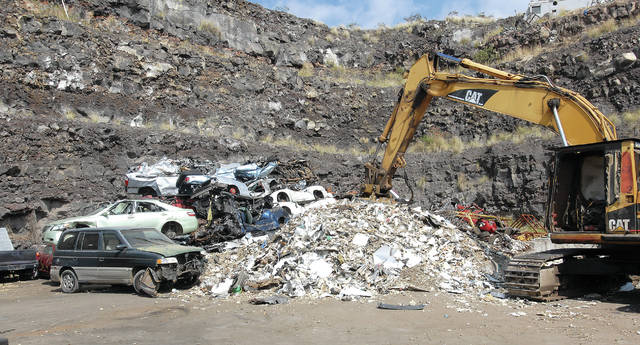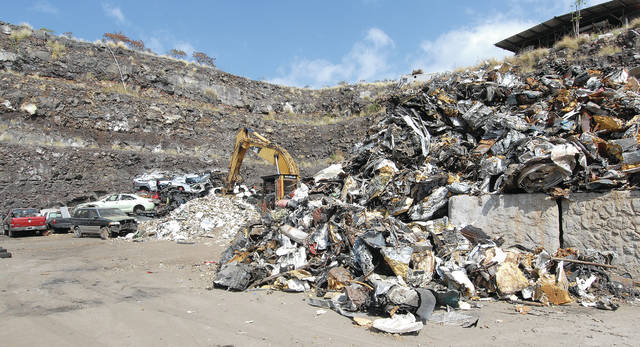KAILUA-KONA — A bill aimed at getting abandoned vehicles off public roads quicker in Hawaii passed a state Senate committee this week with overwhelming support.
But some Hawaii County officials tasked with removing ditched cars said the issue isn’t that simple.
Hawaii County’s director of environmental management said the proposal conflicts with other state law and could jeopardize a vehicle owner’s ability to get his or her car back.
The proposal, which also has a companion bill in the state House of Representatives, would amend the state law that empowers counties to remove abandoned vehicles from public roadways. But rather than saying counties may take custody of those vehicles and dispose of them, the bill would require counties to do so within 10 days of the vehicle’s abandonment.
Rep. Cedric Asuega Gates, (D-Oahu), who introduced the House version, said the bill obligates counties to “deal with these safety and environmental hazards in a timely manner.”
The Senate bill sailed through a Public Safety, Intergovernmental and Military Affairs and Transportation and Energy joint committee hearing. Members on both committees unanimously recommended Thursday it be passed with amendments. A committee report on the bill was not available.
The bill still must go through the Senate Committee on Ways and Means.
A House committee hearing on the companion bill hasn’t been scheduled.
But while public testimony for the proposal was overwhelmingly in favor of the bill, Hawaii County Department of Environmental Management (DEM) Director William Kucharski said it conflicts with another law requiring counties give ample notice before disposing of the car.
State law requires counties give written notice to a vehicle’s registered owner immediately after taking a vehicle into custody, giving the owner 10 days, or 20 for an out-of-state address, before taking further action.
But if the proposed bill becomes law, the 10-day window for counties to take possession of and dispose of a vehicle would lapse before the window of time counties must give owners to collect the vehicle.
Kucharski said he wouldn’t have a problem with a 10-day window to dispose of a vehicle from the time a vehicle is officially considered abandoned.
“We do that anyway,” he said.
In Hawaii County, when a report of an abandoned vehicle comes in, a Hawaii Police Department officer will locate the vehicle and attach a notice advising the owner to remove it within 24 hours.
If it’s still there the following day, an officer initiates a report, which ultimately goes to the DEM. The department then arranges with a contracted towing firm to remove the rig within 72 hours.
Kucharski estimated that once a report is received from police, the vehicle is removed within 72 hours 90 percent of the time, and 100 percent of the time within a week.
Those that aren’t removed, he said, are because the department hasn’t been notified or they don’t have the authority to remove it because it’s not in the county’s jurisdiction, such as when it’s on private property or state land like a beach.
“I’d love to go down there and remove it,” Kucharski said, “but I don’t have the authority.”
Kucharski reiterated his points in testimony he submitted to the committee. Similar opposition was filed by the City and County of Honolulu’s director of customer services and Maui’s abandoned vehicles administrator, who said the bill, “ultimately, is not feasible.”
Kucharski and police said they believe the problem is much better than it has been.
While reports of abandoned vehicles have increased in recent years, the rate at which it’s increased has slowed.
In fiscal year 2014-15, there were 480 reports of abandoned vehicles on Hawaii Island, according to DEM. That number jumped 75 percent the following year to 841 reports and 33 percent over that to 1,121 reports in fiscal year 2016-17.
Only a small portion of reported abandoned vehicles that are towed are later claimed. In fiscal year 2016-17, only 23 of the 750 vehicles towed were later claimed by the owner, a number consistent with prior years, even as the number of overall reports has climbed.
Hawaii Police Department Maj. Robert Wagner said police do their best to track owners down when they make their reports, but abandoned vehicles often have stripped VINs, are unregistered or have a pending notice of transfer, leaving police unable to identify the person responsible for abandonment.
In the past, abandoned vehicles were more commonly those that had broken down on the side of the roadway. For the most part, Wagner said, those were registered vehicles and easier to trace to owners. Given the cost now associated with scrapping vehicles, he said, people are towing their cars and leaving them on the side of the road.
And while abandoned vehicles are still an issue, HPD Community Policing Sgt. Roylen Valera said he feels it’s a lot better than six months ago because of better coordination between police and DEM to streamline the process of responding to reports of abandoned vehicles, a point with which Kucharski agreed.


